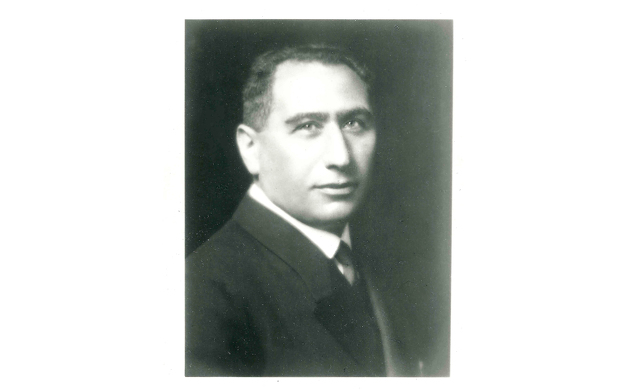150th birthday anniversary of Lipót (Leopold) Aschner
Today marks the 150th anniversary of the birth of (Lipót) Leopold Aschner, who served as the CEO of Tungsram between 1921-1944. Aschner was a self-made man and a top manager of the interwar era, whose legacy lives on.
Lipót Aschner, born as the second son of a large Jewish family in the small village Assakürt (in present-day Slovakia) on January 27, 1872, succeeded in realizing the American dream in Hungary. From age 15, he served as junior commercial clerk at various companies, among them Rimamurány-Salgótarján Iron Works Ltd., one of the largest Hungarian companies at the time. In 1892, at 20 years of age, he entered into the service of Egger B. et Co., the forerunner of Tungsram, as junior clerk and rose to the position of CEO in 1921. In the 1930s, he was board member at several other companies and financial institutions, and served as a long-time vice-president of the Association of Hungarian Iron Works and Machine Building Companies. His professional achievements were the result of determination, self-discipline, constant learning (languages, organization and management, up-to-date and minute knowledge of the market) and an ability to choose his colleagues well. His self-discipline and inner strength showed at their best during his deportation to Mauthausen and his subsequent strive to support Tungsram in rebuilding its international network during his stay in Switzerland.
Under his management, Tungsram became the third largest producer of incandescent lamps and radio valves in continental Europe, after Philips and Osram/Telefunken. Aschner completed Tungsram’s development into a vertically integrated company and built a network of sales offices and production sites in Europe to tackle growing protectionism in international trade. As a member of international cartels, Tungsram was an active participant of the regulatory processes concerning the light source, radio valve and radio set markets, and became a leading exporter in Hungary.
Though resolute in wage negotiations, Aschner valued a skilled and committed workforce. Tungsram was among the first companies in interwar Hungary to establish such company welfare institutions as medical services, a large canteen, and generous sports and recreational facilities. Tungsram supported company cultural associations as well (choir, theatre group) and opened a library. Aschner and Tungsram were major sponsors of the Újpest Athletic Club (UTE) where Aschner served as secretary from 1895 and president from 1921 to 1934. Aschner and his wife supported many charities.

Aschner’s legacy has been, however, the most far-reaching in supporting organized research. Before WWI, Tungsram had earned a solid reputation in the light-current industry under the management of technical director József Pintér, but organized research was vital if the company was to keep up with the accelerating speed of technological development following the war. Among his very first acts as CEO, Aschner appointed Ignác Pfeifer, former Professor of Chemical Technology at Royal Joseph University, as head of research and ensured that sufficient funds were dedicated to research even during the Great Depression. Professor Pfeifer, as the first director of Tungsram Research Laboratory - the first such institution in Hungary -, built a team of researchers of international reputation who contributed to the development of light sources, radio valves, photocells, picture transmission, etc. At Aschner’s initiative, Tungsram’s donated funds to establish the first chair for Nuclear Physics at the Royal Joseph University of Technology and Economics. Zoltán Bay, former professor of Theoretical Physics at the university in Szeged and head of Tungsram Research Laboratory from 1936, was appointed as Professor of Nuclear Physics in 1938. Students flocked to his lectures even from other universities until he emigrated to the USA in 1948. Following the devastation of WWII, the successful Moon radar experiment, led by Professor Bay at Tungsram, demonstrated the strength of Hungarian industrial research and spread hope of revival during times of dire need. The introduction of the planned economy went hand in hand with the reorganization of research and the establishment of national scientific and industrial research centers following the Soviet model, integrating company R&D departments. Tungsram researchers assumed leading positions in three such institutions: the Research Institute for Telecommunication (TÁKI, 1949-1994), the Institute for Industrial Research in Telecommunications (HIKI, 1953-1981), and the Institute of Technical Physics (MÜFI, 1956-1998). Some of the laboratories operated at Tungsram Újpest and at Tungsram factories often served as test fields for new developments. As a result, the successful management principles of the interwar Tungsram Research Laboratory were transplanted into these institutes and Tungsram researchers played a crucial part in Hungary’s efforts to keep up with the rapid development of new types of light-sources, transistors, semi-conductors, special metals, microelectronics, measuring technologies, vacuum technology, and several other fields.
Aschner’s legacy is a source of inspiration and testament that despite modest financial resources success can be achieved with a determination, self-discipline, transnational network-building and cutting-edge knowledge.
Written by Mária Hidvégi


